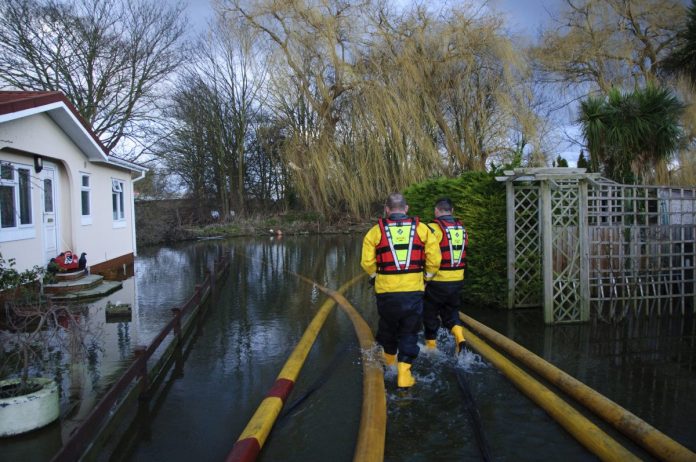Matthew Elliott, director of engineering at WYG, warns that flood defence spending may not deliver the kind of protection we expect – but only another catastrophe will highlight the shortcoming
Although 2017 was a tumultuous year politically, rainfall patterns have fortunately been rather benign to date: a dry and mild winter followed by an arm and rather dry spring. The summer and autumn rainfall has generally not strayed far from average. What, then, are the prospects of another winter of widespread flooding misery? While long-term weather forecasting is still in its infancy, we can and should plan to protect ourselves from floods based on evidence from climate and hydrological records of past events.
Our current system of flood defences has evolved over many years, often as an immediate political response to a major flood, rather than a consistent national strategy that is based on scientific evidence. As a result, the nation’s defences do not provide an acceptable standard of protection (SOP).
It is also a harsh reality that whatever SOP is provided, it will not be sufficient to protect against all eventualities, leaving a residual risk that must be managed. There is also disagreement about where the priorities for protection should lie and the extent to which systems of ‘hard defences’ should compromise wider environmental objectives.
It is important to appreciate that there are several types of flooding. The UK government’s listings of civil emergencies now distinguish between three types of flooding: coastal, river and surface water flooding.
In the recent civil emergencies risk register, published in September, coastal and river flooding were given equal ranking ahead of surface water flooding. Previously, coastal flooding had been given greater focus, no doubt recollecting the devastating coastal floods of January 1953, when over 300 people lost their lives along the east coast of England. The impact of a major surge-induced coastal flood on the extensive coastal lowlands along the east coast of England would understandably be much greater than an equivalent return period event of river or surface water flooding.
Currently, the government is in the second financial year of its six-year, £2.5bn investment programme to improve our system of defences against all types of flooding. The government is keen to point out that they are investing record levels to improve flood defences – £2.5bn between 2015-16 and 2020-21 – and that this represents a real-term increase in capital investment, up from £1.7bn in the last parliament and £1.5bn between 2005 and 2010.
Cost-benefit analysis is a key decider in how the £2.5bn of government investment is spent. This mechanism prioritises the defence of residential properties over business properties, infrastructure and agricultural land. However, the cost-benefit mechanism does favour wealthy urban areas (such as in the South East of England) where property values are higher and any supplementary funding that may be needed to see a project through is more likely to be available.
With investment in flood defences having arguably increased, leading academic experts remain concerned. The Climate Change Adaption Evidence (2016) emphasises “there is an urgent case for stronger policies” to address “flooding and coastal change risk to communities, business and infrastructure”. Additionally, the Environment, Food & Rural Affairs Committee report Future Flood Prevention argues that “current flood risk management structures are fragmented, inefficient and ineffective”.
Others claim that the six-year, £2.5bn investment programme itself unfairly favours the South East. While the cost-benefit analysis that underlies flood defence spending decisions clearly does favour wealthier urban areas, it is not the only reason why investment is skewed towards the South East.
Climate change experts predict the highest increases in fluvial flows and sea levels (relative to the land) in the South East of the UK. If this is considered alongside the Thames Estuary defence system, the South East is evidently an area of national importance. For example, the Thames Estuary 2100 Plan highlights how 1.3m people and £275bn worth of property in the area will continue to be protected from tidal flood risk for the next century under the scheme. These numbers make such projects justified national priorities.
Clearly, funding for improved flood defences is not limitless. The industry is already hampered by skills shortages in delivering cost-effective solutions at current levels of investment. This is where planned and strategic investment in skills and industry training is fundamental to the progression and development of both defence initiatives and project delivery.
There is a clear case that current investment levels are not sufficient to match the expectations of society, which will only be highlighted if further major flooding occurs this winter. Unfortunately, another dry winter will simply allow the matter to remain out of the headlines, resulting in a ‘status quo’ on investment and delivery structure. No doubt, the government is heavily preoccupied with other issues; however, the next nationally devastating flood cannot be permanently postponed.
Matthew Elliott
Director of Engineering
WYG
Tel: +44 (0)113 2192554
matthew.elliott@wyg.com
www.wyg.com
Twitter: @wyggroup
Facebook: WYG plc
LinkedIn: WYG group














